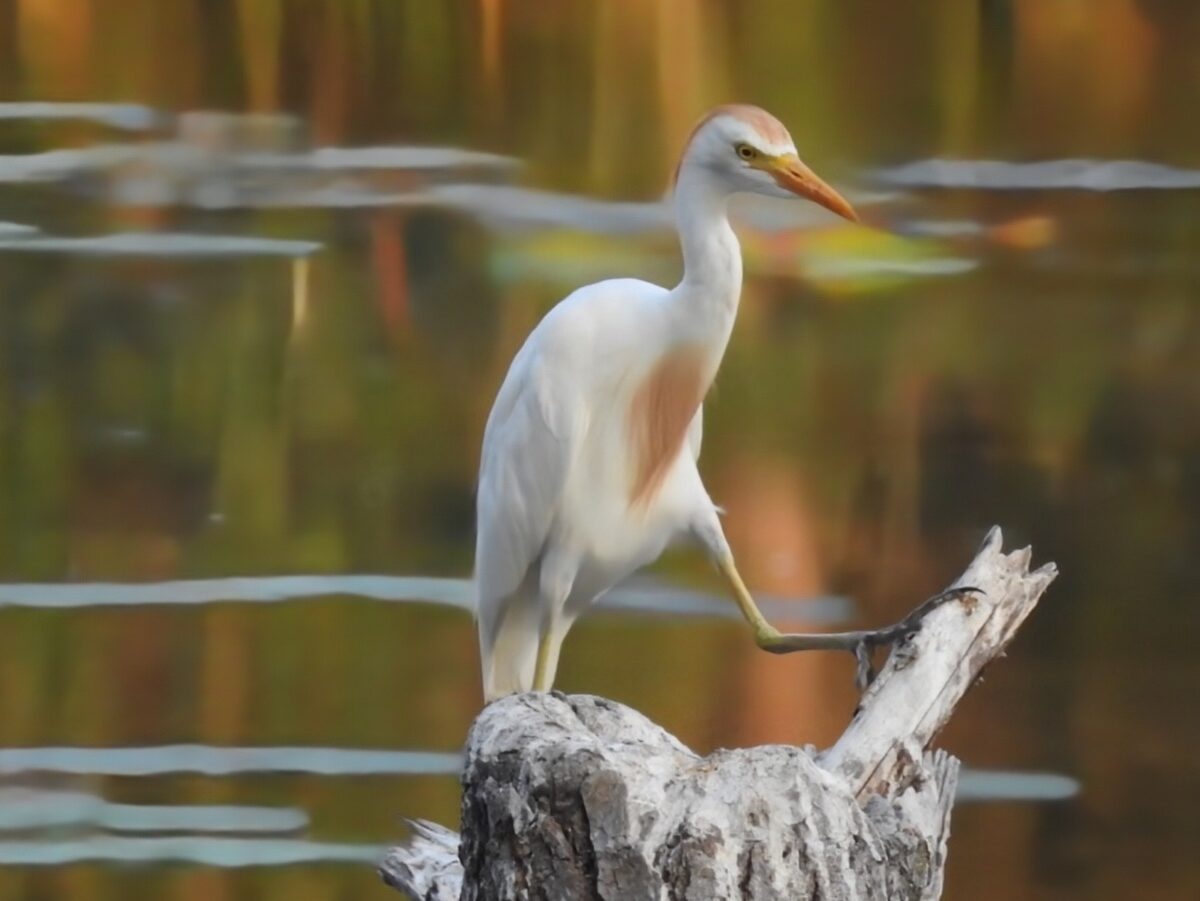Learn all about the western cattle egret, a bird often found in pastures alongside cows. See what the species looks like and sounds like.

How to Identify a Western Cattle Egret

On This Page
Western Cattle Egret Identification

At first glance, you might confuse a western cattle egret with other white egrets. To make sure you’re seeing the correct species, look for a medium-sized bird with a compact neck, shorter neck. During breeding season, western cattle egrets will boast orange-ish red feathers on the backs of their heads, their breasts, and the backs of their wings. In addition, their bills and feet go from black to a bright red.
“They have a distinctive, hunched look,” Whitney Yoerger, communications and outreach manager for Indiana Audubon, says. “They’re very stocky and short-necked compared to some of the other herons and egrets, like the great blue heron or the great egret.” Whitney chuckles as she describes their walk: “They look really nerdy, as compared to other egrets, I would say. They’re not as elegant.”
Range and Habitat

While making sure the bird matches one’s field guide is always a good step, perhaps the best way to tell whether you’re seeing a western cattle egret is to observe where the egret is. Western cattle egrets tend to prefer drier pasture habitats over rivers — and amusingly, they’re often found near farm animals.
“They’re in my mother’s neighborhood because they have sheep grazing all the time, and I’m constantly seeing western cattle egrets hanging out in that area,” Whitney says.
If you’re looking to spot a western cattle egret, you’d have the best luck doing so in the southern United States. While they can occasionally be found elsewhere in the country during breeding season and fly through most of the country during migration, their typical range extends through most of the Southeast, with some birds remaining year-round along gulf coastlines and in Florida.
One Birds & Blooms reader reported a recent sighting of this species and wondered if it was unusual.
“A cattle egret was in our pasture in late November and stayed after a cold front. We live only a mile from Lake Erie in northern Ohio. Is it normal for an egret to venture this far north so late in the year?” asks reader Patricia Hull.
Birding experts Kenn and Kimberly Kaufman say, “Although the much larger great egret is fairly common around lakes and rivers in northern Ohio from spring through fall, the cattle egret is more of a rare visitor, showing up in pastures and marshes mostly in summer. In recent years, however, there has been a trend for a few to arrive in fall and stay into early winter, for no obvious reason.”
Bird Name Change
Kenn and Kimberly say, “The name of this bird has changed as of July 2024: It’s now officially the western cattle egret (formerly known as the cattle egret), to distinguish it from a related bird in Asia and Australia.”
Western Cattle Egret Diet

Unless you see farm animals grazing when you look out your window, you’re not likely to find a western cattle egret in your backyard. “Their primary diet is not something you can provide in a feeder,” Whitney says. “If you are living in more of a rural area with cattle, there’s a likelihood that you could see them, possibly, if you’re in their range.”
She explains that the relationship between cattle egrets and livestock is long-standing and well-documented: the farm animals stir up bugs, which the birds then eat.
Nesting Habits

As with other larger birds, western cattle egrets only have one brood in a breeding season. They typically build nests in trees, with both halves of the pair working on nest construction. Clutch sizes usually include two to four eggs, and young might leave the nest as early as two weeks after hatching.
These egrets, like cowbirds, have also been known to deposit their eggs in the nests of other species of egrets as well as herons.
Calls and Sounds
Bird sounds courtesy of the Cornell Lab of Ornithology
According to Whitney, you’re far more likely to see a cattle egret than you ever are to hear one. “They are really only vocal on their breeding grounds, in the colonies where they’re roosting or nesting,” she says. “They have distinct call types, but in general, you’re not going to be listening for them to make noise.”
If you do hear them, it’ll likely be a harsh raa call or croaks.
Learn how to identify a green heron.
Are Western Cattle Egrets Native to the U.S.?

A surprising tidbit many might not know about these birds: while they’ve certainly adapted to life here, they aren’t technically native to the United States. “They came over from Africa, and they began spreading in the late 1800s,” Whitney explains. “It’s pretty quickly that they arrived in South America. Then they came further north to Florida, and then they were through the United States.”
While Whitney says they’re considered non-native, she mentions that in most places, they’re not considered invasive. “They’re now part of our world,” she says. “While they don’t belong here, they’re part of our diversity.”
Next, learn all about wading birds.
About the Experts
Outdoor enthusiast Whitney Yoerger is the communications and outreach manager for Indiana Audubon. Whitney is also a member of the board of the directors for the Indiana Wildlife Federation.
Kenn and Kimberly Kaufman are the official bird experts for Birds & Blooms. They are the creators of the Kaufman Field Guide series and they lead birding trips all over the world.
Sources
- Cornell Lab of Ornithology, “Western Cattle Egret“
- Audubon Field Guide, “Western Cattle Egret“
- Audubon, “The Cattle Egret“




















